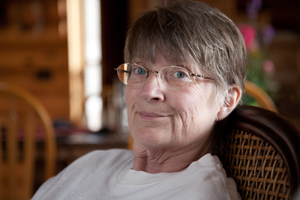
When John Kerr's wife Dale was given a terminal diagnosis in 2007, breast cancer, there was "no question" she wanted to die at home.
It was a 10-day stint in the hospital following a bad reaction to oral chemo that convinced her, Kerr remembers. After returning to their ranch in Tatlayoko Lake, B.C., Dale announced she "was not going to die in the goddamn hospital, no way," he says.
It was then that Kerr contacted a hospice organization in Williams Lake, about 260 clicks from home, for help. They gave him some pillows, found him a stool for the shower. A hospital bed was already floating around the community; Kerr snapped it up and brought it home.
"Dale would spend her day in the hospital bed in the living room," he says. "That was the regime. Get your meals, get through the day."
Towards the end of Dale's life, a nurse from a local clinic would drop in once or twice a week to comfort her. And when the part-time doctor living nearby visited, "it was like somebody had opened the door, and air blew in the house," Kerr says. But given the couple's relative isolation, there wasn't any help on a day-to-day basis.
Kerr became his wife's chief caregiver at the end of her life, a difficult experience for anyone. But living in remote B.C., where attitudes towards health care are guided by what Kerr calls some "very outdated values," did not make it any easier, he adds.
"There were a couple of times where I just had to get out," he says. "I remember going away one time for 36 hours, and asked a friend if she would come and babysit. I was beginning to come unglued."
The B.C. government has recognized the need for increased assistance for rural end-of-life caregivers, creating provincial guidelines for support in 2006, offering a drug and medical supplies benefits program for terminally ill patients, and last month launching an after-hours nursing telephone help line for caregivers. But a recent study by a team of researchers at UBC Okanagan -- which collected the experiences of rural caregivers like Kerr -- concludes there's more work to be done, and better coordination of services needed.
Seeking solutions, they've spearheaded two new projects to help those who suddenly find themselves both a primary caregiver and grieving family member when a loved one is dying in rural B.C.
Coming home
Over 600,000 British Columbians live at least 60-minutes away from a palliative care bed, according to a 2010 study by researchers at Simon Fraser University. Not surprisingly, care is less consistent in rural areas than urban, with limited health care expertise available to patients and families.
Despite that fact, not everyone wants to die in a city hospital.
In her five or so years of researching palliative care, Barb Pesut has come to understand the importance of being able to die at home, wherever located. Health and geography are "very intertwined," says the UBC Okanagan School of Nursing assistant professor, and she stresses the necessity of having options.
A current Canada Research Chair in Health, Ethics and Diversity, Pesut and a team of colleagues recently received funding for two new studies to find ways to ease the experience of rural caregivers like Kerr. One, funded by the BC Nursing Research Initiative of the Michael Smith Foundation for Health Research, will train nurses in palliative care and link nursing students with patients and families in the early stages of end-of-life.
"One of the things that we always hear, what people documented consistently in our research, (is) the lack of health care provider education as it relates to end-of-life care," says Pesut.
The other study, funded by the Peter Wall Solutions Initiative, involves a trial run for an "integrated palliative approach team" to support patients in the early stages of end-of-life. Based in the Trail-Castlegar area, it aims to centralize care by creating a coordinator position -- a single point of contact for patients and families.
It will also seek ways to bridge the paid and unpaid caregiving sectors, from medical professionals to volunteer chaplains to funeral directors, and organize them more effectively to meet the needs of rural patients and families.
"You want to be addressing their needs hopefully in the last year, not within the last weeks or even months (of life)," says Pesut. "It's helping families earlier in the process, getting them connected into the resources they need, the systems they need."
The coordinator for the pilot project, Brenda Hooper, has worked as a nurse involved with palliative care in the Trail-Castlegar area for more than 30 years. Her job will be to steer rural patients and families to the services they need, before they even need them.
"Until you buy a red Volkswagen, you don't see red Volkswagens. But when you buy one, then you see them all over the place," she says. "It's the same thing when you're dying yourself or someone close to you is dying; you don't think about what you need for health care until you need it."
'Radio Dad'
Carolyn McTaggart, who cared for her father Joe at the end of his life, knows intimately the need for guidance in rural palliative care. A former marine estimator, Joe moved into his daughter's home in Crescent Valley, B.C. after his brain tumour was given a terminal diagnosis in 2008.
"That was a challenge because I'll tell you, you've got to hit the ground running when you've got to learn palliative care on the go," she says.
McTaggart's family came up with some inventive ways to keep Joe comfortable. They set up a baby monitor and walkie talkies so that McTaggart could be outside feeding her horses and remain in constant touch with her father -- a set-up she refers to as "Radio Dad." Her husband brought home sushi and jelly babies, taste sensations to liven up the days.
When Joe's illness worsened and began to physically impact him, the family became eligible to receive support. Home care and nurses visited, though the drives for care workers were long and sometimes treacherous. One minute Joe would need a cane, the next a walker, and the next he couldn't get up at all, meaning endless trips to town and the local Red Cross, open only when volunteers were available to staff it. Without a formal point of contact, McTaggart says she was often blindly navigating through the days, relying the Internet for tips on how to comfort her father, alleviate dry eyes, and safety-proof her home.
Fortunately, a occupational therapist friend of the family helped out. But it would've been nice, McTaggart says, if there was someone to give her and map, a list of what to expect, and say: "This is what it looks like. These are questions you need to know to ask, this is information you need to know to go forward."
McTaggart's experience supports findings of a previous study by Pesut and colleagues, which investigated the palliative care needs of B.C.'s rural communities and how they measure up to current realities. They found that, just as McTaggart describes, the formal coordination of care presents a major challenge in rural areas. Rural communities often lack a dedicated palliative system that includes a recognized palliative care physician, social worker, and other support.
"They won't necessarily have 24/7 access to palliative expertise," Pesut explains. "When you don't have that, then much of the burden falls to family care providers."
She adds that most rural patients and families she's interviewed are used to living with less. That's why her team's latest research will focus less on the question of "Why don't we have everything here?" but rather "How can we do this best in the places that we've chosen to live?" If rural communities are used to doing without, the question for end-of-life care is how to build on the capacity that already exists, she says.
For McTaggart, simply knowing where to get help would've made a huge difference.
"If I hadn't had my best friend, an occupational therapist, and her family to walk me through the process, I wouldn't really have known where to go," she says. "Here, it's always the story of make do with less. And in terms of health care, that's hard." ![]()
Read more: Health















Tyee Commenting Guidelines
Comments that violate guidelines risk being deleted, and violations may result in a temporary or permanent user ban. Maintain the spirit of good conversation to stay in the discussion.
*Please note The Tyee is not a forum for spreading misinformation about COVID-19, denying its existence or minimizing its risk to public health.
Do:
Do not: